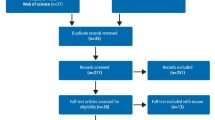Abstract
Data sources
PubMed, Pubmed Clinical Queries, EMBASE, the American Dental Associations Evidence-Based Dentistry Website, Cochrane Library, Web of Science, repository of the Journal of the American Dental Association and Google Scholar.
Study selection
Four authors independently assessed the abstracts of studies resulting from the above searches which compared treatment of root caries in an older population with SDF versus other preventive agents or placebos.
Data extraction and synthesis
Titles and abstracts of all reports identified through the electronic searches were assessed independently by four authors based on agreed upon inclusion and exclusion criteria. Of the selected studies for final inclusion in the systematic review, study quality was assessed using the critical appraisal worksheet for randomised controlled trials from the Oxford Centre for Evidence-Based Medicine (CEBM 2005). Prevented fraction (PF), number needed to treat (NNT) and relative risk (RR) were calculated as outcome measures in each study. In addition, the published evidence on SDF was reviewed in order to formulate clinical recommendations on safety and effectiveness when treating root or coronal caries in an adult population with SDF, as well as treatment of dental hypersensitivity.
Results
Three randomised controlled trials were identified that addressed the effectiveness of SDF on root caries in older adults, but none addressed coronal caries. Root caries prevented fraction and arrest rate for SDF were significantly higher than placebo. The prevented fraction for caries prevention for SDF compared to placebo was 71% in a three-year study and 25% in a two-year study. The prevented fraction for caries arrest for SDF was 725% greater in a 24-month study and 100% greater than placebo in a 30-month study. No severe adverse effects were observed.
Conclusions
Existing reports of SDF trials support effectiveness in root caries prevention and arrest, remineralisation of deep occlusal lesions and treatment of hypersensitive dentine.
Similar content being viewed by others
Commentary
The typical elderly patient is changing. We have an aging population of patients in general, who are living longer, retaining more teeth into their old age and these patients are living with chronic medical conditions.1 Our elderly patients will have accumulated restorative trauma to their dentition over the years whilst also suffering gingival recession, with associated root surface exposure in the context of medication-related xerostomia.2 We know that removing caries does not reduce the risk of future caries.3 Indeed, if anything repeated caries removal only serves to weaken teeth further4 leading to teeth which are at high risk of fracture.5,6 Thus, it can be concluded that in our high caries risk patients we must intensify caries preventative measures7 and shift the focus of treatment from ‘reparative’ operative procedures to less invasive non-operative management.8
It is most interesting to read about the use of silver diamine fluoride (SDF) and its application in an older population.9 This treatment modality has been mainly used and studied in children and is so effective that it is referred to as a ‘caries silver fluoride bullet.’10 SDF treatment is easily implemented, inexpensive, safe and can be applied less frequently than alternative preventative treatments.11,12 In one study, one application of SDF has been shown to achieve a similar clinical result to four applications of sodium fluoride varnish.13
This systematic review by Hendre et al.9 initially aimed to investigate the effectiveness of SDF application in coronal caries as well as root caries in an older adult population using a PICOS formulated question during data search. Three high quality randomised controlled clinical trials13,14,15 were selected for inclusion in the final review but each of these studies focussed on root caries alone – highlighting the paucity of high quality data available pertaining to SDF application in coronal caries in an adult population. Nevertheless, before making clinical recommendations the authors evaluated the published evidence regarding the safety and effectiveness of SDF using two additional clinical studies16,17 in younger adult populations which supported extending the use of SDF for remineralisation of coronal caries and treatment of hypersensitive teeth. The authors of this commentary certainly feel that in the absence of high quality, robust data, alternative evidence is worthy of consideration in this manner.18
We note however that within the inclusion and exclusion criteria the authors of this systematic review explicitly excluded non-English language studies. Such a decision may result in important and relevant studies being overlooked. It would be interesting to see if non-English language centres have investigated the effect of SDF on coronal caries in an older adult population. Furthermore, the authors did not explicitly mention if they made personal contact with experts in the field and they did not explicitly screen for unpublished studies. Again, in circumstances where there is a lack of data for systematic review it is important to exhaust all avenues in a literature search and we feel it is important to report that these measures were taken such that scientists in other centres may replicate a study if deemed necessary.
Quite a nice aspect of this systematic review is the knowledge gap analysis section. Having carried out a comprehensive review of the literature, the authors acknowledge that in spite of a lot of evidence in support of SDF treatment in children and increasing evidence to support its use in older adults, we still require data to support effective application frequencies to prevent and arrest caries and we also must assess the aesthetic acceptability of this treatment modality in older adults. In this way, we can more effectively target future research towards these knowledge gaps.
Practice point
-
Existing reports of SDF trials support effectiveness in root caries prevention and arrest, remineralisation of deep occlusal lesions and treatment of hypersensitive dentin in older adults.
References
Chalmers JM . Minimal intervention dentistry: part I. Strategies for addressing the new caries challenge in older patients. J Can Dent Assoc 2006; 72:427–433.
Featherstone JD, Adair SM, Anderson MH, et al. Caries management by risk assessment: consensus statement, April 2002. J Calif Dent Assoc 2003; 31:257–269.
Featherstone JD . The caries balance: contributing factors and early detection. J Calif Dent Assoc. 2003; 31:129–133.
Larson TD, Douglas WH, Geistfeld RE . Effect of prepared cavities on the strength of teeth. Oper Dent 1981; 6:2–5.
Reeh ES, Messer HH, Douglas WH . Reduction in tooth stiffness as a result of endodontic and restorative procedures. J Endod 1989; 15:512–516.
Dietschi D, Duc O, Krejci I, Sadan A . Biomechanical considerations for the restoration of endodontically treated teeth: a systematic review of the literature--Part 1. Composition and micro- and macrostructure alterations. Quintessence Int 2007; 38:733–743.
Kidd E . Caries control from cradle to grave. Dent Update 2010; 37: 651–652, 654–656.
Innes NP, Frencken JE, Schwendicke F . Don't know, can't do, won't change: barriers to moving knowledge to action in managing the carious lesion. J Dent Res 2016; 95:485–486.
Hendre AD, Taylor GW, Chávez EM, Hyde S . A systematic review of silver diamine fluoride: Effectiveness and application in older adults. Gerodontology 2017; 34:411–419.
Rosenblatt A, Stamford TC, Niederman R . Silver diamine fluoride: a caries “silver-fluoride bullet.” J Dent Res 2009; 88:116–125.
Horst JA, Ellenikiotis H, Milgrom PL . UCSF Protocol for Caries Arrest Using Silver Diamine Fluoride: Rationale, Indications and Consent. J Calif Dent Assoc 2016; 44:16–28.
Schwendicke F, Göstemeyer G . Cost-effectiveness of root caries preventive treatments. J Dent. 2017; 56:58–64.
Tan HP, Lo EC, Dyson JE, Luo Y, Corbet EF . A randomized trial on root caries prevention in elders. J Dent Res 2010; 89:1086–1090.
Zhang W, McGrath C, Lo EC, Li JY . Silver diamine fluoride and education to prevent and arrest root caries among community-dwelling elders. Caries Res 2013; 47:284–290.
Li R, Lo EC, Liu BY, Wong MC, Chu CH . Randomized clinical trial on arresting dental root caries through silver diamine fluoride applications in community-dwelling elders. J Dent 2016; 51:15–20.
Sinha N, Gupta A, Logani A, Shah N . Remineralizing efficacy of silver diamine fluoride and glass ionomer type VII for their proposed use as indirect pulp capping materials. Part II (A Clinical Study). J Conserv Dent 2011; 14:233–236.
Castillo JL, Rivera S, Aparicio T, et al. The short-term effects of diammine silver fluoride on tooth sensitivity: a randomised controlled trial. J Dent Res 2011; 90:203–208.
Ferriter M, Huband N . Does the non-randomized controlled study have a place in the systematic review? A pilot study. Criminal Behav Ment Health 2005; 15:111–120.
Author information
Authors and Affiliations
Additional information
Address for Correspondence: Susan Hyde, Department of Preventive and Restorative Dental Sciences, UCSF School of Dentistry, San Francisco, CA, USA. E-mail: susan.hyde@ucsf.edu
Hendre AD, Taylor GW, Chávez EM, Hyde S. A systematic review of silver diamine fluoride: Effectiveness and application in older adults. Gerodontology 2017; 34: 411–419.
Rights and permissions
About this article
Cite this article
McReynolds, D., Duane, B. Systematic review finds that silver diamine fluoride is effective for both root caries prevention and arrest in older adults. Evid Based Dent 19, 46–47 (2018). https://doi.org/10.1038/sj.ebd.6401304
Published:
Issue Date:
DOI: https://doi.org/10.1038/sj.ebd.6401304



